by scott.gillum | Jan 19, 2016 | 2016, Marketing
 Go ahead and get mad at me. Feel free to fill up the comment section below. I’m going to share our closely held secrets with sales people, skeptics and other critics of marketing. I know you would rather I not, but it’s best for all of us, trust me. Here we go…
Go ahead and get mad at me. Feel free to fill up the comment section below. I’m going to share our closely held secrets with sales people, skeptics and other critics of marketing. I know you would rather I not, but it’s best for all of us, trust me. Here we go…
#1 – You got lucky – if you generate leads off the first drop/wave of a new account acquisition or a lead generation campaign for a solution, you’re more likely to be lucky, than right. Yea, you may have had a compelling offer, and the call to action was intriguing, but the chances are, you just happened to hit a prospect at the right time.
Sure, in some industries you can buy data that identifies a company’s spend on certain products or services. But you don’t know if the budget is available, what portion of it, or who controls it. And since this is a prospect, you are most likely targeting a title, which could be a decision maker, a budget holder, or just a curious information seeker.
At the beginning of a campaign you simply don’t have the information on a prospect to know where they are, or how to advance them in the buying process. So, if a prospect does put their hand up and says, “Call me,” you most likely hit them at the right time in the buyers’ journey.
#2 – Your messaging is weak – the effectiveness of your message is being compromised by the fact that you are trying to motivate an audience to think or feel differently without explaining why. According to Pat Spenner, co-author of the new book entitled The Challenger Customer, marketers spend too much time focusing on how they want audiences to think, or feel, without understanding their current mindset.
Research for the book found that the receptiveness and/or openness to a message depends heavily on an audience’s existing belief system, which drives their behavior. According to Spenner, marketers first need to understand and break down the audience’s current mindset using insights about their business, customers, markets, etc. It’s an opportunity to “teach” audiences that their current thinking is no longer valid and why a new way of thinking is needed. If done well, the new mindset will uniquely lead them back to your product/services or brand.
For example, Merck developed the cholesterol-lowering drug Mevacor at a time when doctors knew little about the effects of cholesterol on the body. The current mindset was that hypertension (high blood pressure) caused heart disease. Merck used clinical research to show doctors the impact of high levels of cholesterol on arteries and the correlation of plaque buildup with coronary heart disease (the “teaching” moment).
As a result, doctors should test patient’s cholesterol levels to see if they are at risk. If a patient had a LDL cholesterol level above a certain point, doctors should start with a therapy regiment that included diet and drug treatment (the new mindset). The only cholesterol-lowering agent available at the time was, you guessed it, Mevacor. Merck, by getting doctors to change their mindset about the causes of heart disease, lead them back to their product. As Spenner puts it, effective story telling for marketers should “lead to, not with.”
#3 – You’re doing lead nurturing the wrong way – changing mindsets takes time. Yes, you’ve built prospect profiles, aligned content to their interest, and you may even know how to engage them in their preferred communication channel. The problem may not be your content marketing efforts but the fact that prospects are stuck in the status quo. They may find your information interesting, but it hasn’t convinced or motivated them to change their behavior.
Nurturing efforts should continue to break down, or build up, the new mindset across the buying group. The ability to drive specific information aligned to individual buyer’s needs may actually be causing more dysfunction within an already dysfunctional group. To advance a prospect/s refocus efforts on driving consensus on the issue and solution within the buying group. If done correctly, like Merck, prospects will come to own conclusions that you offer the best solution for their needs.
Motivating an audience to change doesn’t happen overnight. Unfortunately, marketers are under constant pressure to perform and rarely have the luxury of time to change their approach. It’s the reason I shared the first dirty secret, to buy marketers time to create the type of campaigns that deliver insights told as a story revealed over time.
The first wave of your campaign will generate leads, but it’s the waves that come after that really count. If marketers can stop telling customers why they need their product and let them come to that conclusion on their own, response and conversion rates will double based on my experience. But don’t tell anyone, it’s a secret.
by scott.gillum | May 11, 2015 | 2015, Marketing
Look at the tweet, then read the graphic. Why is the headline on this tweet by Spencer Stuart, “Majority of marketing leaders want to see data-and analysis driven decision marketing on their teams,” and not “Majority of marketing leaders want to see more creative thinking and exploration on their teams?”
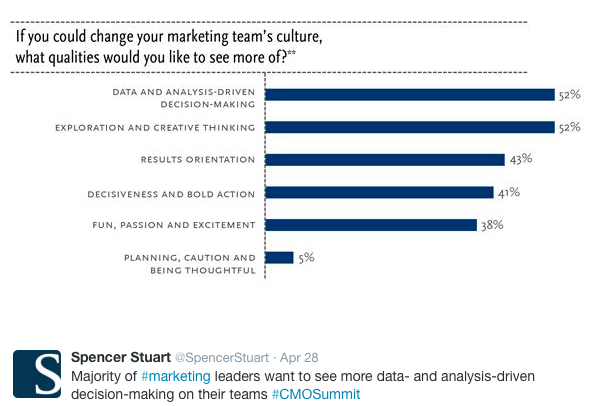
Statistically they’re the same, yet Spencer Stuart emphasized the data/analytic decision making why? “Combine Fun, Passion and Excitement” with “Decision and Bold Action” and you have a solid argument for changing the marketing team’s culture to “Exploration and Creative Thinking.”
On the flip side, only 5% of marketing wants a culture of “Planning, Caution and Being Thoughtful,” amen brother. Ok, I hear you, “if it was “fun” they would call it “play” not work, but maybe we need a little more play at work.
According to Peter Gray, a professor at Boston College and author of Free to Learn, ”play” can be the key that unlocks the mindset of bold creative thinking. In an article on Psychology Today, Gray says that the “alert but unstressed condition” of a playful mind has been shown repeatedly, in psychological experiments, to be ideal for creativity and learning new skills.
“Experiments have shown that strong pressure to perform well (which induces a non-playful state) improves performance on tasks that are mentally easy or habitual for the person, but worsens performance on tasks that require creativity, or conscious decision making, or the learning of new skills.” Although accountants may perform well under pressure, it could be a creativity killer for marketers.
One could conclude then, if an organization too narrowly focuses on “analysis and data driven decision making,” it may come at the expense of “Exploration and Creative Thinking” mentioned in the research and Tweet. Said differently, all work and no play, could make your marketers dull.
Pressure to perform in business marketing is a given, so how do you strike a healthy balance? Stephanie Anderson, CMO of Time Warner Cable’s business division, suggested that by ” focusing on business results first, ensuring that you have a way to show the business impact of marketing activities, you’ll have the foundation in place in order to inject a fun and creativity into the workplace.”
by scott.gillum | Jan 12, 2015 | 2015, Marketing
Just in time for the cold and flu season, scientists have recently discovered that the “Pareto principle – the 80/20 rule” applies to infectious diseases. “Super Carriers” who represent 20% of the population, are responsible for transmitting 80% of infectious diseases.
 Superspreaders, like “Typhoid Mary” of the 1900’s, have the ability, although not fully understood, to infect others without falling ill themselves. Come in contact with the one of them, live in a densely populate area, and you’ve got the recipe for a massive outbreak.
Superspreaders, like “Typhoid Mary” of the 1900’s, have the ability, although not fully understood, to infect others without falling ill themselves. Come in contact with the one of them, live in a densely populate area, and you’ve got the recipe for a massive outbreak.
Like viruses, information is spread in similar ways. The importance of “links per node” in social network influence has been studied for years. Research has shown that it’s not the number of links, but rather how “strategically placed” people are in the core of the network, that leads to dissemination of information or disease through a large fraction of the population.
“Typhoid Mary” for example, was a cook in New York City and had an opportunity to infect large groups of patrons with typhoid fever breakfast, lunch and dinner. Readers of The Hot Zone, or Dan Brown’s Inferno, will also be familiar with the concept of geometric progression’s role in the spreading of disease.
Applying these same principals to the distribution of information yields some important insights for content marketers. Given the nuclear arms race going on in content creation and distribution, finding a way to get your message to, and consumed, by targeted audiences is becoming mission critical.
Superspreaders are a perfect route, and represent an opportunity to narrow your message. Think about it this way instead of trying engage 80-100% of your target audience (being everything to everyone) which is a sure fire way to get lost in the noise, you need only to appeal to the right 20%.
How do you find them? It begins with the mind shift of moving from quantity of contacts, to the quality of those contacts…their place in the network. If your organization is set on measuring social media by the number of fans, followers, etc. you’ve got your work cut out.
Find and profile the key influencers in your industry, and/or on a particular subject matter, and don’t solely rely on social media…you’ll end up with “false gods.” Ask the sales force, monitor speakers on industry events, search for authors on the topic, and scan the academic horizon. Once you’ve created your list, study their language.
Now, use your PR and social monitoring tools, as well as other sources, to understand how and what they communicate. Narrow in on those influencers who are in the right position to distribute your content to the right audience, and not those who may have the most followers and/or may be the most active. “Right position” may be related to position to audience, but it may also include, adding validity to your information.
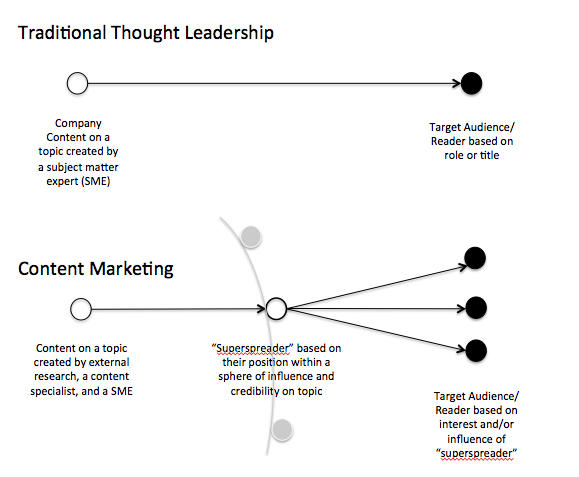
In the digital world, the credibility of the content source is as important, if not more important than, as the actual author/content producer. In the past, companies aimed thought leadership campaigns directly at audience on topics they wanted to communicate. Success with content marketing depends on targeting key influencers with topics that resonate with them in their language so they will pass the information on to their followers.
As a result, you may want to score social spreaders (not a Klout score, use your own ranking) based on their influence (position + credibility). Set a goal for the year to get their attention through a mention or a share, just as you might do with targeted media. Tell your story by designing a content strategy based on the topic areas, language, and the interests of your superspreaders. Then let your “Typhoid Mary or Larry” spread your information…it’s called viral marketing for a reason!
by scott.gillum | Jan 4, 2015 | 2015
It’s the time of the year to look back over the last 12 months and create a “best of” list. This year I’ve pulled the most popular posts from five different sites; Adage, Business2Community, Forbes, Fortune and LinkedIn. In addition, I’ve thrown in a few other noteworthy nuggets from the year at the end of the post.
Adage – Why Apple Pay Could be Huge, And It’s Not What You Think explored the potential upside of Apple Pay as an advertising platform. It sparked the most conversation, and debate, on Twitter. Time will tell if they this strategy will come to fruition.
Business2Community – 5 Key Tips and Da ta Points to Defend You 2015 Marketing Budget. The last post of the year required the most man hours, and it was the most reposted story of the year. It offers marketers help with their 2015 planning activities in the form of free research and benchmark data.
ta Points to Defend You 2015 Marketing Budget. The last post of the year required the most man hours, and it was the most reposted story of the year. It offers marketers help with their 2015 planning activities in the form of free research and benchmark data.
Forbes -the most popular and shared post of the year, Could Falling Test Scores Be a Good Thing for the US? explores the link between test scores and success in business. It also highlights the risk associated with over emphasizing left brain analytic skill development, outlined by Sir Ken Robinson in his Ted Talk video Do Schools Kill Creativity? The endorsement of Marc Andreessen certainly played a big role in the popularity of the post.

Fortune – Are Marketers Measuring the Right Things was the first post I wrote for our new partnership with Fortune. It profiles the efforts of Ciena, a networking company, to elevate marketings role, and importance, within the organization. The post highlights an unique survey tool used to gather feedback from the sales organization on the performance of marketing (see the dashboard below).
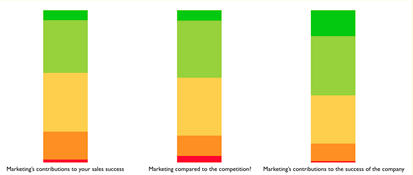
LInkedIn – 2014 marked my first year publishing on LinkedIn. Based on my experience so far, I’m not convince it will viable platform for content unless it becomes better policed. Too much promotional material seems is making its way on to it. At this point, I’m not sure I’ll continue to post.
That said, the most popular post on LinkedIn was also one of the most popular on Adage. The Keys to Differentiating Your Company From Others provides tips on how marketers can humanize their corporate brand to better resonate with audiences. It also identifies one of the common flaws of B2B communication – thinking that what you sell…is who you are. Hopefully, it also helped generated a new client for a follower.

Bonus Stuff
A couple of other noteworthy happenings from the year.
Moving on up.
The Next Generation of Apps Will Be All About You post that ran on Advertising Age was reprinted in the Sept/Oct version of The Portal magazine, a bi-monthly publication produced by the International Association of Movers.
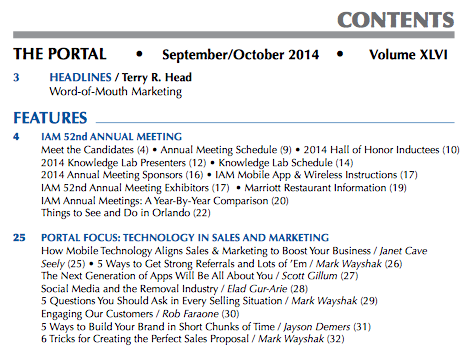 Taking Center Stage
Taking Center Stage
Karen Walker, SVP at Cisco, highlighted my post Everything We Thought We Knew About B2B Marketing is Wrong in her presentation at this year BMA member meeting in Chicago. The post now has close to 70,000 views.
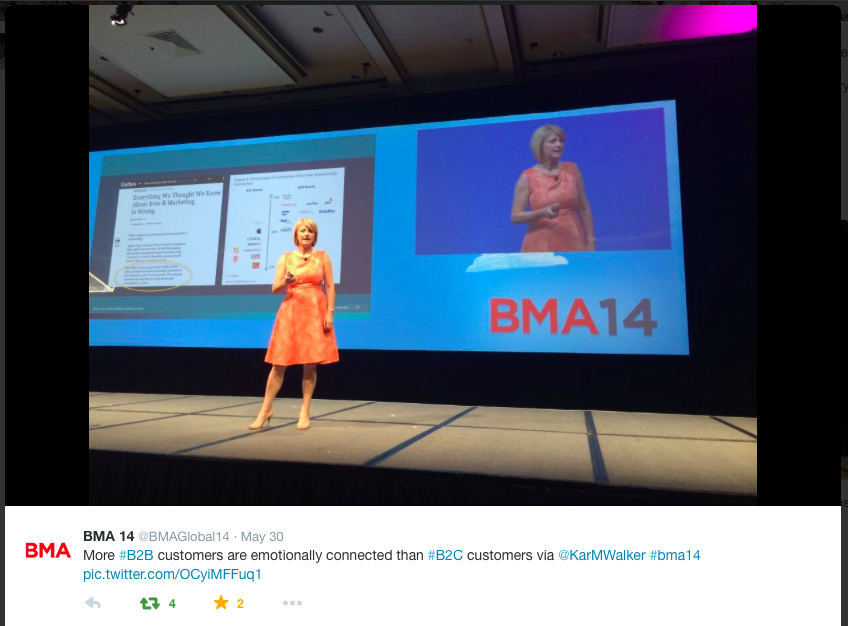
Happy New Year! Here’s to an exciting year to come.
by scott.gillum | Nov 7, 2014 | 2014, Marketing
The 2015 planning season is upon us. It’s the time of year when the C-Suite is busy sharpening their elbows to ready themselves for the budget brawl. To help arm marketers for this blood bath, I’ve pulled together benchmarks and/or research needed to defend and win marketing dollars. Here are some answers, and sources, for your five toughest budget questions.
- How much should we be spending on marketing? It’s a classic question and a favorite of CEO’s everywhere. The mere mention of it is enough to stop marketers in their tracks. Fortunately, the AMA, McKinsey and the Duke Fuqua School of Business have got your back with their 2014 CMO Survey. Section 3 of the report contains data from 350 marketers on their spending from digital to people and programs. The research even breaks spending out by size of company, type of company (B2B or B2C, and B2B products or services). The report is packed with valuable information — it’s a “must have” for any marketer this year.
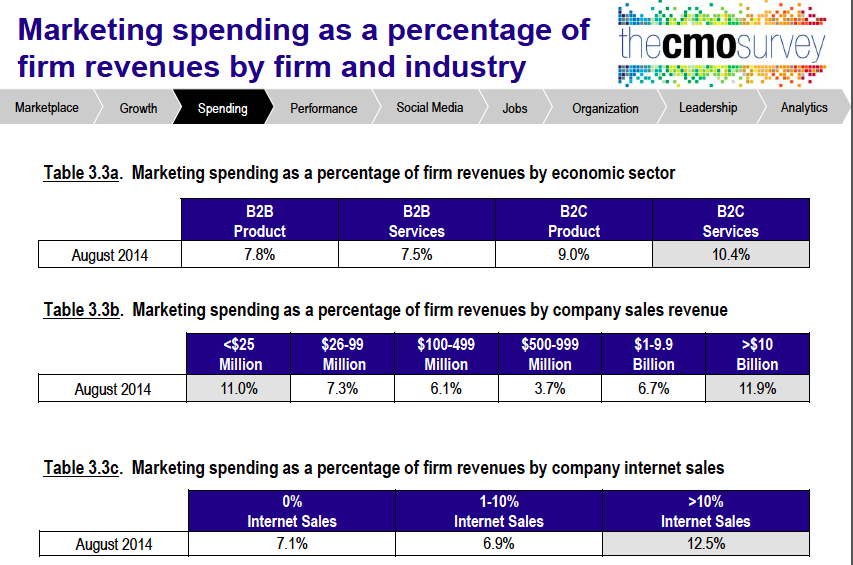
- What should the mix between people and programs? This question comes shortly, if not immediately, after the question above. Ten years ago the general benchmark ratio was 40/60, forty percent of the budget went to staff and the remaining to program spending. Now it’s the reverse, 60/40 people to program spending, for a number of reasons. The biggest factor has been the need for specific skill sets that are in high demand relating to analytics, social media and content marketing have driven up staff cost. Need more information, here’s a useful infographic on the real cost of social media, including salary cost for staff.
- Where should we invest? Typically, this is a teaser question, and could also be asked as; “if you had an incremental $1 (or $10K, $100K, etc.) where would you invest it?” Keep in mind that just because the CEO is asking the question doesn’t necessarily mean you’ll get the incremental funding, but you better be able to answer the question. To do that see IBM’s C-Suite Priorities report entitled The Customer-activate Enterprise. The research, collected from face to face interviews with over 4000 senior executives, provides insights into the priorities of each member of the C-Suite. The top priority in the report is Digital. Including everything from increasing responsiveness to customers, to making the organization more agile and responsive. Specific priorities for CMO’s, it’s about capturing; analyzing and using customer data across touch points.
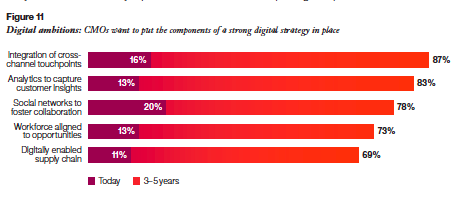
- What’s the payoff/return/business impact of Social Media? There are a number of sources that you could tab into to help develop a response. I’ve always been a fan of HubSpot’s State-of-Inbound. Additionally, if you have downloaded the CMO Study mentioned in bullet #1, there is a whole section on Social Media (see graphic). Interestingly enough after four years “Visits” and “Followers/Friends” are still the leading social media metrics today. Personally, I’m not a fan, try using measurements related to engagement. Note the gains being made in “Conversion Rates” and “Buzz Indicators” over that last four years. This is the result of the development of better measurement tools. Here’s a great cheat sheet from SocialMediaToday on the Top 50 Tools. For digital and mobile benchmarks download Adobe Digital Index’s Best of the Best Report.
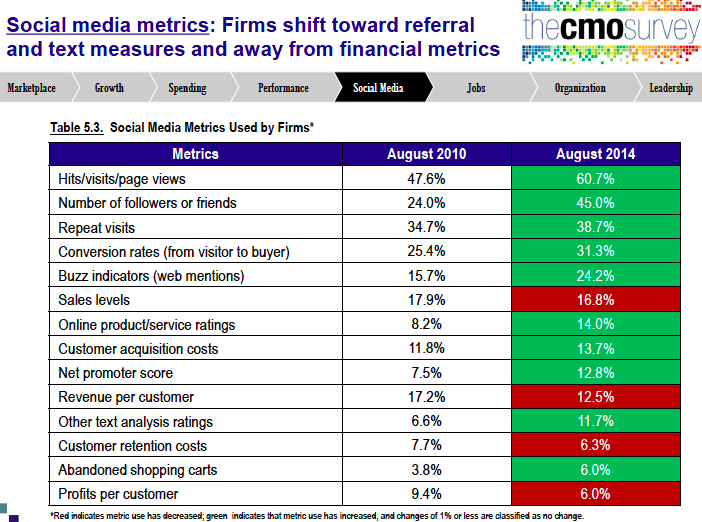
- What return should we expect from our marketing investments? This is a loaded question. Recognize that what the executive really wants to know is: “What will marketing do for me and/or my group?” As a result, answer the question based on their area of interest, and in their language. If it’s a sales executive, talk in terms of new leads, customers and pipeline value. If it’s the CEO, talk about brand value, revenue growth or customer retention or loyalty. Rarely is this question asked on behalf of the organization as a whole. Even more rare, is the executive that believes the numbers you’ve quantitatively derived for a ROI.
Lastly, go in strong and ask for a bigger budget. Here’s a report to keep in your back pocket in case you need it, Gartner’s CMO Spend 2015: Eye on the Buyer. The report will support your request for an increase, and maybe help the “powers that be” understand that if you’re not getting a bigger budget, your key competitors probably are…now go get ‘em!
 Go ahead and get mad at me. Feel free to fill up the comment section below. I’m going to share our closely held secrets with sales people, skeptics and other critics of marketing. I know you would rather I not, but it’s best for all of us, trust me. Here we go…
Go ahead and get mad at me. Feel free to fill up the comment section below. I’m going to share our closely held secrets with sales people, skeptics and other critics of marketing. I know you would rather I not, but it’s best for all of us, trust me. Here we go…



 ta Points to Defend You 2015 Marketing Budget
ta Points to Defend You 2015 Marketing Budget












